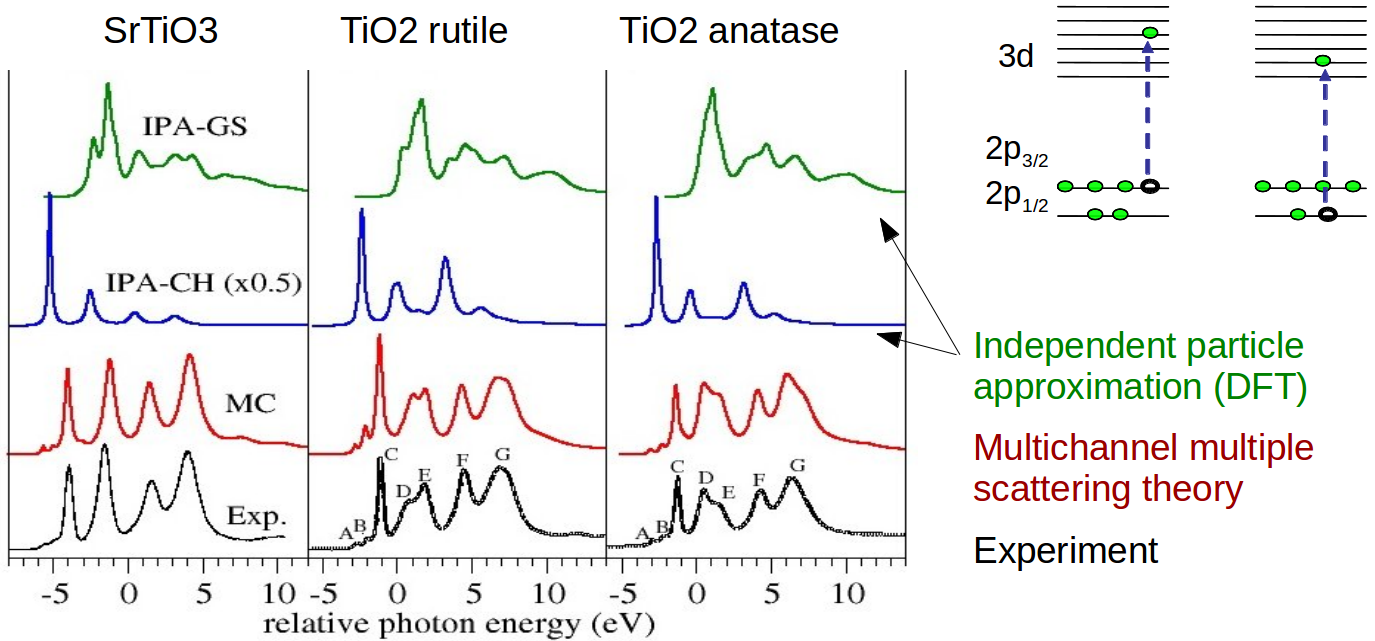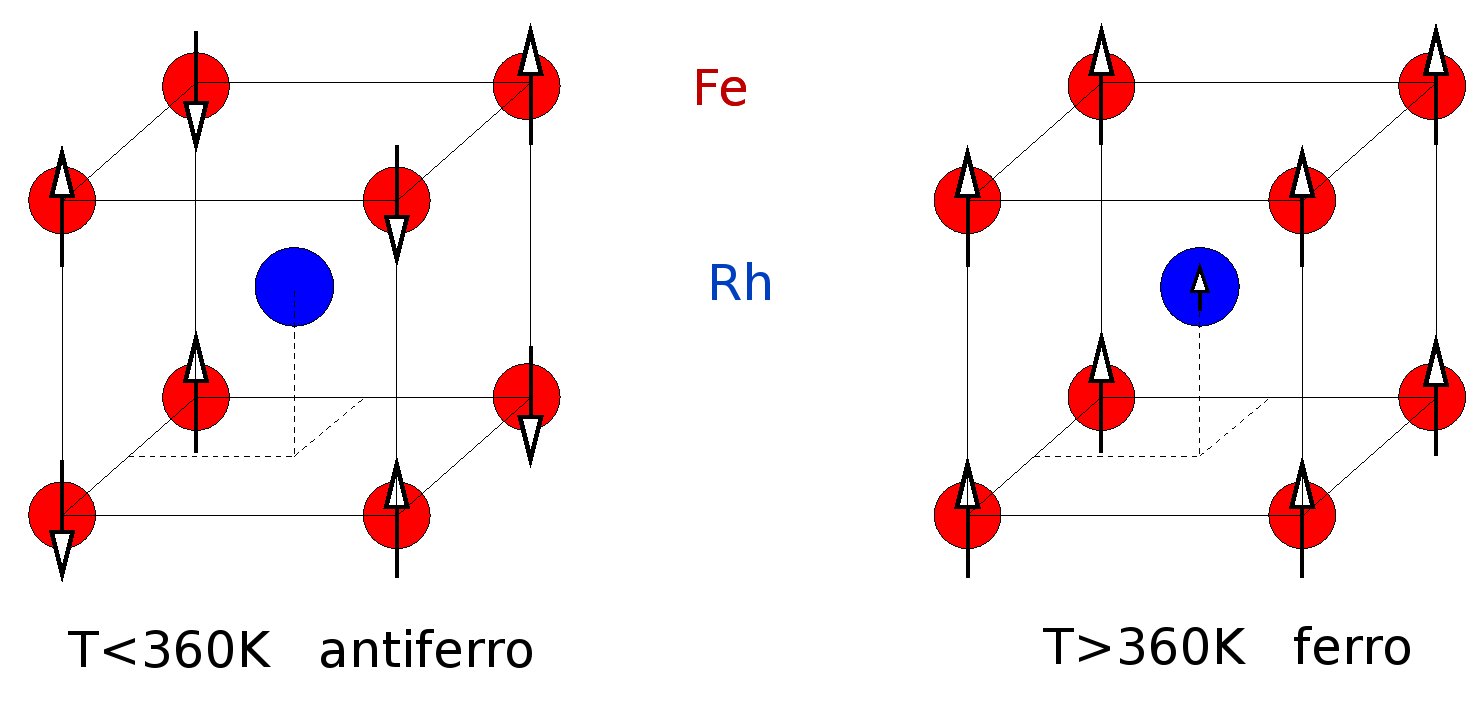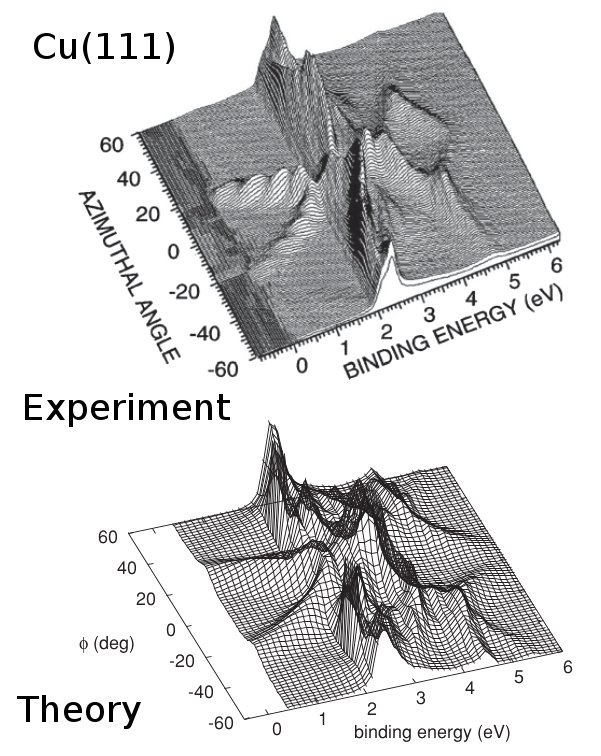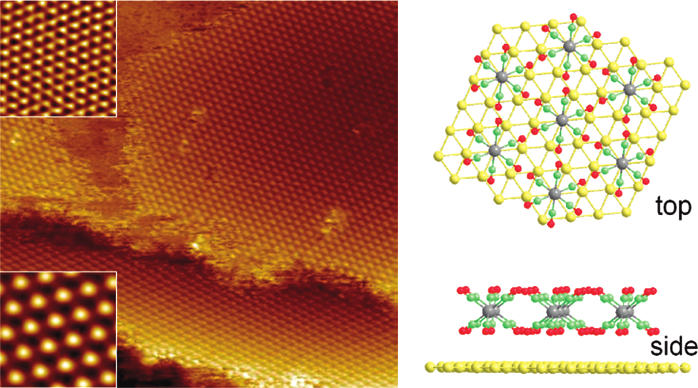Key Word
表面、分子吸着、電子構造、理論、第一原理計算、多重散乱、エキサイテーション、分光、角度分解電子、X線吸収スペクトル
- We study the electronic and magnetic properties of surfaces, interfaces and novel nanosized materials, such as TiO2 nanotubes and films or metal-organic molecules.
- Through first principles electronic structure methods, we compute ground state properties and electron spectroscpies, especially X-ray absorption and valence and core-level photoelectron emission.
- New computational methods based on multiplet and multiple scattering theory have been developed for X-ray absorption and photoemission spectra.
Research
Recent Topics
X-ray absorption spectra of transition metal L-edges calculated with multichannel multiple scattering theory.
 X-ray absorption spectroscopy at the transition metal L23-edges
is a powerful tool for element specific information about
local coordination, bonding and magnetism.
Due to strong core-hole effects, especially multiplet couplings,
one-electron schemes such as density-functional
theory fail to reproduce the spectra and atomic model calculations
are generally used where all extra-atomic effects are reduced
to an empirical ligand field.
We have developed a multichannel multiple scattering theory for
L23-edge absorption which features the precise electronic structure of
the material through density functional theory, but also
includes the major final state correlation effet, namely
particle-hole multiplet coupling. The L23-edge of spectra of TiO2
was reproduced correctly for the first time. The "D-E" level
splitting, fingerprint of the different crystal phases is shown to
reflect the stacking of the TiO6 octahedra on a length scale of 1 nm.
read article
X-ray absorption spectroscopy at the transition metal L23-edges
is a powerful tool for element specific information about
local coordination, bonding and magnetism.
Due to strong core-hole effects, especially multiplet couplings,
one-electron schemes such as density-functional
theory fail to reproduce the spectra and atomic model calculations
are generally used where all extra-atomic effects are reduced
to an empirical ligand field.
We have developed a multichannel multiple scattering theory for
L23-edge absorption which features the precise electronic structure of
the material through density functional theory, but also
includes the major final state correlation effet, namely
particle-hole multiplet coupling. The L23-edge of spectra of TiO2
was reproduced correctly for the first time. The "D-E" level
splitting, fingerprint of the different crystal phases is shown to
reflect the stacking of the TiO6 octahedra on a length scale of 1 nm.
read article
Electronic structure and core-level spectra of magnetic films. Metamagnetic transition in FeRh.
 The FeRh ordered alloy switches from the antiferromagnetic state
at low temperature to the ferromagnetic state above 360 K, which
makes it an interesting material for spintronic applications.
We have studied the electronic structure changes across this
"meta-magnetic" transition of FeRh films using hard x-ray photoemission
spectroscopy and first-principles calculations.
A significant enhancement of the electronic density of states at the
Fermi level are observed for the ferromagnetic state,
implying that the electronic entropy partially drives the magnetic
transition.
read article
The FeRh ordered alloy switches from the antiferromagnetic state
at low temperature to the ferromagnetic state above 360 K, which
makes it an interesting material for spintronic applications.
We have studied the electronic structure changes across this
"meta-magnetic" transition of FeRh films using hard x-ray photoemission
spectroscopy and first-principles calculations.
A significant enhancement of the electronic density of states at the
Fermi level are observed for the ferromagnetic state,
implying that the electronic entropy partially drives the magnetic
transition.
read article
New computational methods for angle-resolved photoemission. Transition metal surfaces.
 A novel real-space multiple scattering
computational method for ultra-violet angle resolved photoemssion and
photoelectron diffraction based on real-space multiple scattering
has been developed.
The interplay between initial and final state effects in ultra-violet
photoemission spectroscopy has been studied for the Cu-3d band from Cu(111)
surfaces.
read article
A novel real-space multiple scattering
computational method for ultra-violet angle resolved photoemssion and
photoelectron diffraction based on real-space multiple scattering
has been developed.
The interplay between initial and final state effects in ultra-violet
photoemission spectroscopy has been studied for the Cu-3d band from Cu(111)
surfaces.
read article
A first principles method has been developed for angle- and spin-resolved resonant photoemission. The link between spin-resolution and circular dichroism in transition metal resonant photoemission at the 2p-3d resonance was studied. We show that the strong spin-polarization of the photocurrent observed in certain of antiferromagnetic systems is not a measure of the local magnetic moments but a consequence of the angular momentum transfer from the light to the photoelectron spin through core-level spin-orbit coupling and exchange-scattering (Auger decay). read article
Defect electronic states in wide-gap semiconductors probed by resonant photoelectron diffraction
 Oxide semi-conductors such as TiO2 have various applications for
opto-electronics, solar energy, catalysis etc.
The band gap states play a major role for transport and
optical properties. We have investigated the defect states at
the n-doped TiO2(110) surface using
resonant photoelectron diffraction,
that is the photoelectron diffraction from the valence defect state
at the Ti-2p-3d resonance. Thereby the charge distribution of the
defect state could be revealed. By comparing O-vacancy doped and
chemically (Na-adsorption) doped surfaces, it is shown that the
defect charge distribution is essentially an intrinsic property
of the Ti(110) surface.
read article
Oxide semi-conductors such as TiO2 have various applications for
opto-electronics, solar energy, catalysis etc.
The band gap states play a major role for transport and
optical properties. We have investigated the defect states at
the n-doped TiO2(110) surface using
resonant photoelectron diffraction,
that is the photoelectron diffraction from the valence defect state
at the Ti-2p-3d resonance. Thereby the charge distribution of the
defect state could be revealed. By comparing O-vacancy doped and
chemically (Na-adsorption) doped surfaces, it is shown that the
defect charge distribution is essentially an intrinsic property
of the Ti(110) surface.
read article
Organic thin films: Adsorption and decomposition of single layer Mo(CO)6/Cu
 Molybdenum carbonyl Mo(CO)6 was adsorbed on the Cu(111)
surface at 160 K in the monolayer coverage range and studied by scanning
tunneling microscopy. A well-ordered monolayer of hexacarbonyl molecules was
observed experimentally for the first time. The monolayer has a hexagonal
structure compatible with a (√7 × √7)R19 superlattice on the copper (111)
plane. The arrangement and orientation of the molecules on the surface were
determined by density functional theory calculations, including van der Waals
interactions. The comparison of adsorption and cohesive energies reveals that
the molecule−substrate interaction is stronger than the intermolecular one,
which
explains the observed two-dimensional growth.
read article
Molybdenum carbonyl Mo(CO)6 was adsorbed on the Cu(111)
surface at 160 K in the monolayer coverage range and studied by scanning
tunneling microscopy. A well-ordered monolayer of hexacarbonyl molecules was
observed experimentally for the first time. The monolayer has a hexagonal
structure compatible with a (√7 × √7)R19 superlattice on the copper (111)
plane. The arrangement and orientation of the molecules on the surface were
determined by density functional theory calculations, including van der Waals
interactions. The comparison of adsorption and cohesive energies reveals that
the molecule−substrate interaction is stronger than the intermolecular one,
which
explains the observed two-dimensional growth.
read article
Vibrational properties of copper oxides
 Copper oxides are used in catalysis and are the basis of
most high-temperature superconductor materials.
Apart from the abundant tenorite CuO and fcc Cu2O phases,
more exotic phases may be stabilized in nanostructures, among them the
paramelaconite Cu4O3 phase.
Knowledge of the vibrational modes is a prerequiste for the
understanding of thermodynamics and electron-phonon coupling.
Using Raman spectroscopy and first principles calculations we have
studied the phonon modes of CuO, Cu2O2 and Cu4O3.
Through a detailed analysis of the displacement
eigenvectors, it is shown that a close relationship exists between
the Raman modes of CuO and Cu4O3.
read article
Copper oxides are used in catalysis and are the basis of
most high-temperature superconductor materials.
Apart from the abundant tenorite CuO and fcc Cu2O phases,
more exotic phases may be stabilized in nanostructures, among them the
paramelaconite Cu4O3 phase.
Knowledge of the vibrational modes is a prerequiste for the
understanding of thermodynamics and electron-phonon coupling.
Using Raman spectroscopy and first principles calculations we have
studied the phonon modes of CuO, Cu2O2 and Cu4O3.
Through a detailed analysis of the displacement
eigenvectors, it is shown that a close relationship exists between
the Raman modes of CuO and Cu4O3.
read article
Density fluctuations in liquids at the nanoscale
 Various thermodynamics quantities are directly linked to the
density fluctuations <n(r) n(r')>-<n(r)><n(r')> and can be computed as
volume integrals over the pair-correlation function <g(r-r')>,
so-called Kirkwood-Buff integrals. In the traditional approach
these integrals converge very badly as a function of the upper
integration bound.
We have derived exact expressions for Kirkwood-Buff integrals over
finite (hyper-spherical) volumes. It is shown that they scale as
1/R with system size and converge much better than the usual
cut-off integrals.
read article
Various thermodynamics quantities are directly linked to the
density fluctuations <n(r) n(r')>-<n(r)><n(r')> and can be computed as
volume integrals over the pair-correlation function <g(r-r')>,
so-called Kirkwood-Buff integrals. In the traditional approach
these integrals converge very badly as a function of the upper
integration bound.
We have derived exact expressions for Kirkwood-Buff integrals over
finite (hyper-spherical) volumes. It is shown that they scale as
1/R with system size and converge much better than the usual
cut-off integrals.
read article
